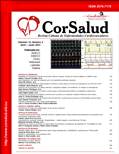Long QT syndrome in pregnant women related to oxytocin administration
Abstract
Introduction: Acquired long QT syndromes may be due to the use of drugs, within which oxytocin is included.
Objective: To identify electrocardiographic disturbances related to intravenous oxytocin administration in pregnant women.
Method: A descriptive-prospective study was conducted with 57 pregnant women who underwent elective caesarean section and were given oxytocin, immediately after fetal extraction, at the Hospital Universitario Gineco-Obstétrico Mariana Grajales in Villa Clara, Cuba, between September 2019 and January 2020.
Results: The 63.2% of the patients had a corrected QT interval < 460 milliseconds (ms) after oxytocin administration, and 24.6% > 470 ms; in the latter, 5.3% had it between 481-500 ms, and equal percentage > 500 ms. No patient presented suggestive symptoms or electrocardiographic demonstration of ventricular tachycardia or other complex arrhythmias.
Conclusions: Oxytocin, given during the placental removal period, resulted in the prolongation of the QT interval above normal values in some patients, without the appearance of cardiovascular symptoms, QT interval dispersion or complex arrhythmias.
Downloads
References
1. Buller Viqueira E, Cabello Pulido J, Ibáñez M.J. Torsade de pointes. Rev Clín Med Fam. 2016;9(1):63-7.
2. Carreras Calvo F, Castellanos Rojas R, Perozo Panicello R, Ramírez Lana L. Síndrome del QT largo y muerte súbita cardiovascular. AMC [Internet]. 2015 [citado 11 Feb 2020];19(3):279-87. Disponible en: http://revistaamc.sld.cu/index.php/amc/article/view/2461/2092
3. Ramalho D, Freitas J. Drug-induced life-threatening arrhythmias and sudden cardiac death: A clinical perspective of long QT, short QT and Brugada syndromes. Rev Port Cardiol. 2018;37(5):435-46. DOI: https://doi.org/10.1016/j.repc.2017.07.010
4. Awamleh García P, Alonso Martín JJ, Graupner Abad C, Jiménez Hernández RM, Curcio Ruigómez A, Talavera Calle P, et al. Prevalencia de patrones electrocardiográficos asociados a muerte súbita en la población española de 40 años o más. Resultados del estudio OFRECE. Rev Esp Cardiol. 2017;70(10):801-7. DOI: https://doi.org/10.1016/j.recesp.2016.11.029
5. Nieto-Marín P, Jiménez-Jáimez J, Tinaquero D, Alfayate S, Utrilla RG, Rodríguez Vázquez Del Rey MM, et al. La expresividad variable del síndrome de QT largo de una familia española se explica por la heterocigosis digénica en SCN5A y CACNA1C. Rev Esp Cardiol. 2019;72(4):324-32. DOI: https://doi.org/10.1016/j.recesp.2018.03.009
6. Fernández Delgado D, Cruz Boza R, Cabrera Pratts AJ, Suárez López JM, Hernández Ortega R. Factores de riesgo asociados a síndrome QT largo en anestesia cardiovascular. Rev Cuba Anestesiol Reanim [Internet]. 2017 [citado 18 Feb 2020];16(3). Disponible en: http://www.revanestesia.sld.cu/index.php/anestRean/article/view/133/507
7. Chávez González E. El intervalo QT, su origen e importancia del conocimiento de fórmulas para su medición en diferentes circunstancias clínicas. CorSalud [Internet]. 2014 [citado 21 Feb 2020];6(1):79-85. Disponible en: http://www.revcorsalud.sld.cu/index.php/cors/article/view/183/416
8. Acoltzin-Vidal C, Rabling-Arellanos E. Retraso de la rama descendente de la onda T en electrocardiogramas sin datos de riesgo aparente de muerte súbita. Gac Med Mex. 2018;154(2):198-201. DOI: https://doi.org/10.24875/gmm.17002940
9. Muñoz-Esparza C, Zorio E, Domingo Valero D, Peñafiel-Verdú P, Sánchez-Muñoz JJ, García-Molina E, et al. Valor del «test de bipedestación» en el diagnóstico y la evaluación de la respuesta al tratamiento con bloqueadores beta en el síndrome de QT largo. Rev Esp Cardiol. 2017;70(11):907-14. DOI: https://doi.org/10.1016/j.recesp.2016.12.028
10. Martillotti G, Talajic M, Rey E, Leduc L. Long QT syndrome in pregnancy: are vaginal delivery and use of oxytocin permitted? A case report. J Obstet Gynaecol Can. 2012;34(11):1073-6. DOI: https://doi.org/10.1016/s1701-2163(16)35437-8
11. Liou SC, Chen C, Wong SY, Wong KM. Ventricular tachycardia after oxytocin injection in patients with prolonged Q-T interval syndrome – Report of two cases. Acta Anaesthesiol Sin. 1998;36(1):49-52.
12. Córdova S, Mela S, Gresa C. El síndrome de QT largo en anestesia. Una revisión a partir de un caso clínico. Rev Chil Anest. 2015;44(2):131-46. DOI: https://doi.org/10.25237/revchilanestv44n02.03
13. Charbit B, Funck-Brentano C, Samain E, Jannier-Guillou V, Albaladejo P, Marty J. QT interval prolongation after oxytocin bolus during surgical induced abortion. Clin Pharmacol Ther. 2004;76(4):359-64. DOI: https://doi.org/10.1016/j.clpt.2004.06.005
14. Guillon A, Leyre S, Remérand F, Taihlan B, Perrotin F, Fusciardi J, Laffon M. Modification of Tp-e and QTc intervals during caesarean section under spinal anaesthesia. Anaesthesia. 2010;65(4):337-42. DOI: https://doi.org/10.1111/j.1365-2044.2010.06246.x
15. Dorantes Sánchez M. Despolarización y repolarización ventriculares para estratificar riesgo de arritmias ventriculares malignas y muerte súbita. CorSalud [Internet]. 2018 [citado 21 Feb 2020];10(3):266-9. Disponible en: http://www.revcorsalud.sld.cu/index.php/cors/article/view/351/719
Downloads
Published
How to Cite
Issue
Section
License
Authors who publish with this journal agree to the following terms:- Authors retain copyright and grant the journal right of first publication with the work simultaneously licensed under a Creative Commons Attribution License that allows others to share the work with an acknowledgement of the work's authorship and initial publication in this journal.
- Authors are able to enter into separate, additional contractual arrangements for the non-exclusive distribution of the journal's published version of the work (e.g., post it to an institutional repository or publish it in a book), with an acknowledgement of its initial publication in this journal.










